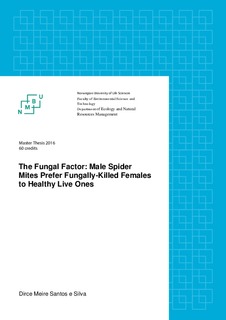| dc.description.abstract | The two-spotted spider mite, Tetranychus urticae, is a serious pest in a wide variety of crops worldwide, and can negatively affect the production of strawberries. Males of T. urticae approach and guard quiescent deutonymph females to increase their chances of fathering offspring, because only the first mate results in fertilization. Male mating behavior is a key step in spider mite reproduction.
This study investigated the behavior of T. urticae males towards females killed by entomopathogenic fungal species in two different taxons: Neozygites floridana (Division Entomophthoromycota, Class Neozygitomycetes, Order Neozygitales) and Beauveria bassiana s.s (Division Ascomycota, Class Sordariomycetes Order Hypocreales). Single males were exposed to one of the following choice situations (treatments), each with two different types of non-moving females present: (A) healthy quiescent deutonymph vs. T. urticae cadaver killed by N. floridana; (B) healthy quiescent deutonymph vs. T. urticae cadaver killed by B. bassiana; (C) T. urticae cadaver killed by N. floridana vs. T. urticae cadaver killed by B. bassiana; and (D) healthy quiescent deutonymph vs. healthy adult freeze-killed. The females were placed individually on two partly overlapping leaf discs. Male behavior was observed and analysed during two minutes every hour for 6 hours. An analog CCTV camera was used to record the experiment, and the second observation in treatments C and D were analysed using Ethovision® XT8 software to observe the distance moved by the males.
Results showed that males visited leaf discs with cadavers killed by fungi significantly more often than discs with healthy quiescent females. Female cadavers killed by fungi were also more touched and guarded by males than the healthy quiescent female. When males were exposed to two disease-free females (Treatment D) touching and guarding towards the freeze-killed female was less commonly observed than towards quiescent female. Further, males moved a longer distance in the presence of two fungal cadavers (C) than in the presence of two disease-free females (D).
The results confirm the earlier finding that males prefer females killed by N. floridana and demonstrate that males exhibit similar behavior towards B. bassiana cadavers. This behavior could compromise the mating goal (chances of fathering offspring) and in addition promote the spread of entomopathogens. Understanding this phenomenon could be important to improve biological control of spider mites, and more research is needed to investigate the mechanism behind the attraction of T. urticae males to fungally killed female. | nb_NO |

